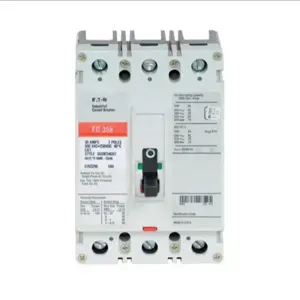Eaton C Series FD3125 bolt-on circuit breaker is designed for switchboard, panelboard, busway and motor control centre (MCC) applications. It is used to protect branch circuit devices from electrical damage.
Features:
- Eaton C Series FD3125 bolt-on circuit breaker comes in a moulded case to protect the electric circuit from faults.
- It comprises a load-side lug for secure connections and allows a toggle-handle actuation method to control the flow of electric current.
- The breaker comes with an ABC phase connection to protect devices from overloads or short circuits.
- This 3-pole unit allows panel mounting for secure installation.
- It comes with fixed instantaneous thermal-magnetic trip to actuate the breaker opening in the event of a ground fault.
Standards and Approvals:
Frequently Asked Questions:
Q. What are the performance ratings of C Series FD3125 bolt-on circuit breaker?
A.
- Amperage Rating - 125A
- AC Voltage Rating - 600VAC
- AIR Rating - 65kA at 240 / 277VAC
- DC Voltage Rating - 250VDC
Q. Why do circuit breakers trip?
A.
- Circuit overloads
- Short circuits
- Ground fault surges
- Defective circuit breaking
- Arc faults
Q. What is the operating temperature rating of this breaker?
A. It can operate at temperatures ranging from -4 degrees to 158 degrees Fahrenheit.
Q. How to tell if my circuit breaker is malfunctioning?
A.
- Breaker trips frequently.
- Burning smell from the circuit box.
- Scorch marks or other signs of damage on the box.
- Breaker does not stay at the reset mode.
Q. What are the things to inspect while using a circuit breaker?
A.
- Remove dust or moisture from the surface of the circuit breaker with a vacuum or cloth. Do not blow debris into the circuit breaker.
- Switch to ON and OFF multiple times to ensure that the mechanical linkages are free.
- Check base, operating handle and cover for any cracks, discolouration & chipping.
- Check connectors and terminals for signs of overheating and looseness.
- Check the mounting hardware and the area where it is installed.
Q. How to install this circuit breaker?
A.
- Check for damage before mounting.
- Check that the mounting panel is predrilled using bolt drilling plan.
- Place the circuit breaker on the mounting surface.
- Position optional terminal end cover (if any).
- After mounting, connect the accessory leads and load terminals.
- Check terminal connecting hardware for correct torque loading.




 In Stock : 171 Units
In Stock : 171 Units
